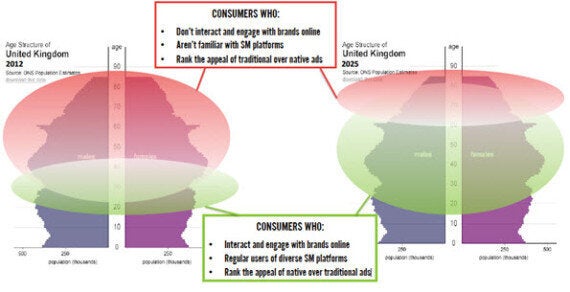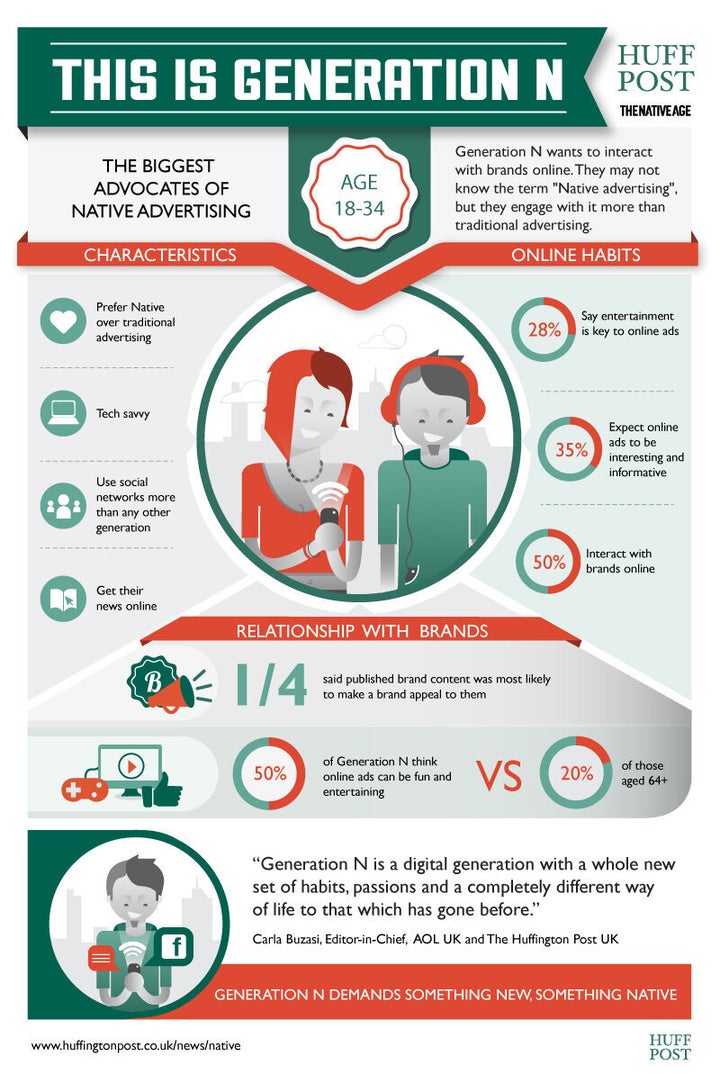
We’ve already outlined the circumstances that have led to the emergence of native advertising. What we can now demonstrate is the simultaneous emergence of a new type of consumer; a digitally-savvy, content-hungry group who don’t want to have their online experiences disrupted by force-fed commercial messaging. Instead, they want to be informed, entertained and engaged; they want a dialogue with brands, and they want to be able to share, discuss, debate, create and broadcast brand content amongst their social networks.
We call them Generation N.
Who are they?
They’re young, mostly in the 18-24 age group, which essentially makes them the future. You’d probably call them Digital Natives; the first group to reach adulthood having grown up with the internet as a big part of their formative years.
For most of their lives, members of Generation N have had access to every piece of information on Earth at their fingertips. Consequently they’ve grown up with a huge thirst for knowledge, but without developing strong loyalties to particular media brands. This is especially true when it comes to their news content, as they didn’t grow up reading newspapers. So what matters most to Generation N isn’t who the content comes from, but how good it is.
They may not know the term ‘Native Advertising’, but our research showed just how much they love it. They see it, interact with it, and engage with it. Crucially, they want to interact with brands online, and have a strong preference for native over traditional advertising.
None of this is to say that native only appeals to Generation N – it’s just that it dovetails completely with their media habits and attitudes to advertising. Older audiences love great content too, but generally they get their news content offline and still tend to prefer traditional advertising. The Church and State metaphor is less broken for the older generation, let’s put it that way.
Some stats from our research*
•Crucially, published brand content is most likely to have a positive impact on young people’s relationship with a brand. More than a quarter of 18-24s said published brand content was most likely to make a brand appeal to them, compared to an 11% average.
•The younger audience says the most important thing in online advertising is interesting and useful content (35%) followed by entertaining and fun content (28%).
•This age group is much more likely to interact with brands online. Almost half of 18-24s interact with brands online, compared to only a quarter of the 64+ age group.
•More than half of the younger audience agreed that online ads could be interesting and useful, compared to just one in five of those aged 64+. Similarly half of those aged 18-24 agreed that online ads could be fun and entertaining – again falling to one in five of those aged 64+.
•Almost a quarter (24%) of the 18-24 age group said they would be most likely to interact with Facebook sponsored stories, compared to an average of 15%. The next most popular among this age group was published brand content (19%, compared to a 9% average). This young age group was less likely to interact with a standard display ad (9%, compared with an average of 15%).
Carla Buzasi, Editor-in-Chief of the Huffington Post, says this young audience is clearly crucial and brands need to find new ways of reaching out; that’s why Native advertising is already working for the Huff Post.
“There are actually brands out there that want to reach that young audience and cannot find them anywhere else,” she says.
“But they can find them on Huffington Post. So you bring that brand to that audience around something, a theme that they are passionate about and that is when you create magic.”
Generation N is an entirely digital generation, with a whole new set of habits, passions and a way of life that’s completely different to that which has gone before. Generation N demands something new – something native.
The Native Age is here to stay
Most of us hold onto the media habits we developed in our younger years. For some, it’s the huge trust we place in our newspaper of choice, for others it’s having the TV at the heart of family life in the living room. We might become cinema lovers because of that magical first big-screen experience, or lovers of magazines that speak to a particular passion. Just as we have taken our preferences with us, so today’s teenagers and 20-somethings will take their preference for native advertising into later life.
One thing’s for sure, they’re not going to suddenly revert to preferring banner ads. We believe the preference that Generation N has for native advertising is here to stay; and when you factor in the changing demographic shape of society, this is an audience and a preference that will continue to grow.
This isn’t just about age; it’s about a generational shift which has only just begun. We have reasons to believe that the online behaviours of Generation N will not change the older they get; in addition, the trend towards online interaction will accelerate as the digital revolution continues to affect our lives in new ways.
As the diagram shows, as Generation N grows up and takes its media habits along with it, there comes a point when the number of consumers preferring native advertising outweighs those who prefer traditional formats.
Based on current ONS data, we believe that by 2025 at the latest, native will be the preferred form of advertising for the majority of the population.

So native advertising is crucial today for reaching the often elusive younger audience. And as this generation grows up and keeps its media preferences, native is set to grow and grow.
What this tells us is that it’s vital for the industry to join the Native Age before they get left behind. Marketers must take the bold step to adapt their approaches now, and seek out those with the editorial skills that are required to create compelling and effective native advertising. Media organisations, for their part, need to recognise the tectonic shift that’s taking place; stop seeing native advertising as ‘selling out’, and embrace it as another means to provide their audience with fantastic editorial content.
* Survey of 2,000 nationally representative UK residents conducted July 2013 by Walk A Mile Research / Kaper UK.

Copy the code below to embed this infographic on your site

Find out more at huffingtonpost.co.uk/news/native